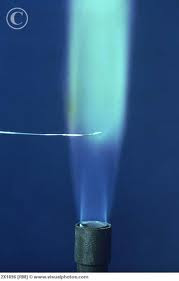We tested using 6 different metals, and 1 additional one being a metal we have tested during our Chemistry module last year.
Barium: Pale green
Calcium: Orange-red
Copper: Blue-green
Lead: Blue
Potassium: Pink
Sodium: Bright orange/yellow
Magnesium: Bright white
Here are the photographs of the flame tests for the different substances. As my camera was not able to capture the colours very well, I found some photos on the Internet instead.
 |
| Barium (http://www.visualphotos.com/image/1x8465577/barium_flame_test) |
 |
| Calcium (http://www.sciencephoto.com/media/4989/enlarge) |
 |
| Copper (http://chemistry.about.com/od/firecombustionchemistry /ig/Flame-Tests/Flame-Test---Copper-Sulfate.htm) |
 |
| Lead (http://chemistry.about.com/od/firecombustionchemistry/ ig/Flame-Tests/Lead-Flame-Test.htm) |
 |
| Potassium (http://www.chemistry.wustl.edu/~courses/genchem/ Labs/IonExchange/Flame.htm) |
 |
| Sodium (http://chemistry.about.com/od/firecombustionchemistry/ig/ Flame-Tests/Flame-Test---Sodium-Carbonate.htm) |
 |
| Magnesium (http://www.bbc.co.uk/schools/ks3bitesize/science/chemical_material_ behaviour/compounds_mixtures/revise5.shtml) |
Another more organised diagram of the different colours created by the different metals.

No comments:
Post a Comment